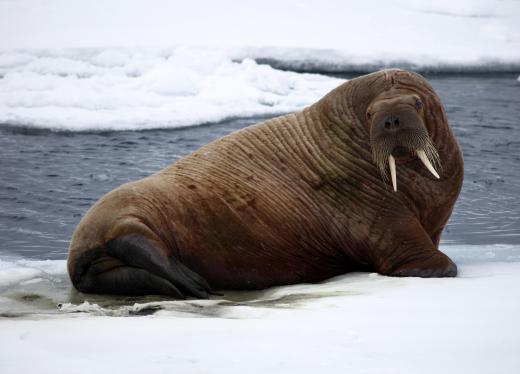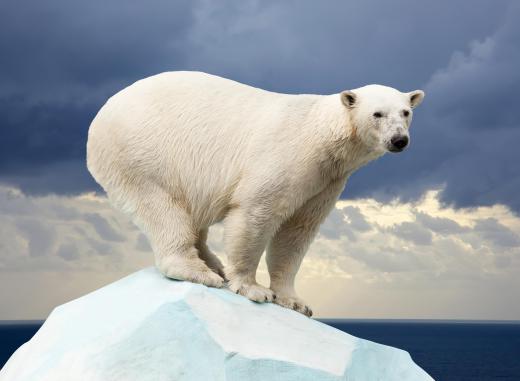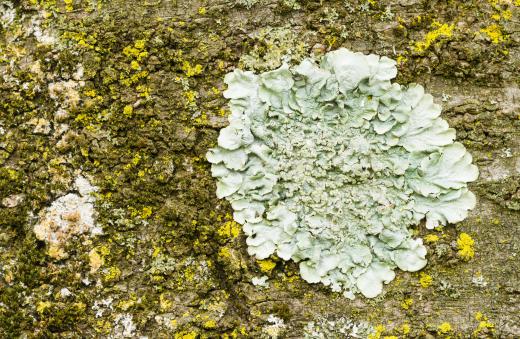What are Some Arctic Animals?
 Michael Anissimov
Michael Anissimov
The Arctic is the northernmost region on the Earth's surface. It is the area surrounding the North Pole. There are several definitions for the Arctic region, but the two most popular refer to anything north of the Arctic Circle, or anywhere the temperature averages less than 10°C (50°F) in July, which roughly corresponds to the treeline. Both are generally the same area, though the latter definition of the Arctic is larger, and includes the Bering Sea, the Aleutian islands, Greenland, Iceland, and parts of northern Canada and Siberia.
Because of extreme cold, sparse ground vegetation (the ground is usually frozen solid), high winds, and dryness, the Arctic is sparsely populated by humans or animals, though both do live there. Arctic animals include lemmings, muskox, caribou (also called reindeer), Arctic fox, wolves, polar bears, wolverines, ermines, Arctic hares, Arctic ground squirrels, seals, and walruses.

All Arctic animals depend on nutrition from the tundra, either directly, as in the case of herbivores, or indirectly, as in the case of predators. Tundra is Arctic land where it is too cold for trees to grow reliably, so the vegetation instead consists of small shrubs, sedges, grasses, mosses, and lichens. Occasionally, there will be scattered trees.

Arctic animals can be divided into small herbivores, large herbivores, and predators. The small herbivores are the most numerous animals, represented by Arctic rodents like lemmings and Arctic ground squirrels, and the beautiful Arctic hare. Although lemmings and Arctic ground squirrels are both rodents, they're quite different. Lemmings are solitary while Arctic ground squirrels are highly social. The squirrels hibernate through the winter while lemmings stay active throughout, braving temperatures dozens of degrees below zero every day. All Arctic animals that depend on shrubs for food must store them to survive the winter, though roots and bulbs will often still be available during this time. Lemmings have longer and warmer fur than Arctic ground squirrels.

Another group of Arctic animals are the large herbivores: muskox and caribou. Both are large, stocky animals, in accordance with Bergmann's rule, which states that animals living in polar regions have a tendency to be larger, probably to retain heat. Both have horns, with the reindeer's displaying complex branching and reaching over a meter (3 ft) in length. Humans in northern regions have hunted and depended on reindeer, even using them for their milk, for thousands of years. This relationship was especially important during the Ice Age, when glaciers covered much of Eurasia and North America, and many human tribes were dependent on reindeer meat to survive the winter.

The remainder of Arctic animals are predators. Predation is a relatively popular lifestyle in the Arctic because of the sparse vegetation, though as in all environments, herbivores outnumber predators. Predators or omnivores in the Arctic include Arctic fox, wolves, polar bears, wolverines, ermines, seals, and walruses. Some of these, like the Arctic fox and polar bear, are a beautiful pure white, which helps them sneak up on prey in the snow. Many Arctic predators eat fish or other sea creatures, especially walruses, which love to eat clams.
AS FEATURED ON:
AS FEATURED ON:














Discussion Comments
Many people seee arctic animals in photos and think that they are "cute." However, many of these creatures are either fierce predators or skittish prey, some which can be very dangerous themselves. Polar Bears in particular are seen as cute by the media, but are deadly creatures. On the island of Svalbard, which is partially owned by both Russia and Norway, people are forbidden to enter certain areas that are are polar bear territory. People who do enter them are expected to go armed and prepared to defend themselves or flee if a bear attacks.
Many arctic animals are endangered. Perhaps the most famous arctic endangered animals are polar bears. Polar bears' habitats have become increasingly more scarce due to climate change, which has melted ice and led to a decrease in many of the animals which are the polar bears' prey.
Post your comments